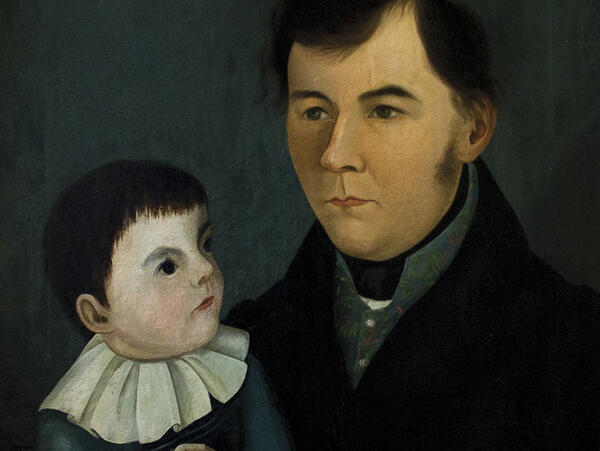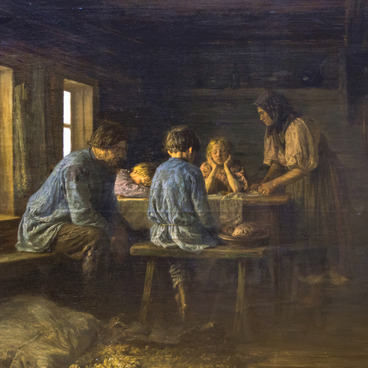The geographical position and social isolation of Siberia influenced the development of the regional fine arts in the 18th — first half of the 19th centuries. It is archaic and provincial in comparison with the art of the European part of Russia, but at the same time it has the local peculiarity. Siberian portrait is a distinctive artistic phenomenon. The museum collection of Siberian portraits contains over a hundred works.
Siberian merchants often wanted to have a family portrait gallery. For almost a century, many famous and nameless artists created a beautiful saga of the Trapeznikov family — a powerful merchant dynasty living in Irkutsk in the 18th — early 20th centuries. The Trapeznikovs contributed a lot to the development of the Siberian economy and culture.
Trofim Trapeznikov, who is considered the founder of the dynasty, comes from the Pomor peasants. In the early 17th century, he arrived in Siberia, where he had a large family. Trofim was a good manager, his two daughters married local merchants, and after that he himself entered the merchant class in Irkutsk.
Pyotr Dmitrievich from the third generation of the Trapeznikovs was one of the most prominent representatives of the family. He earned his fortune by trading furs, which he brought from Kamchatka. Thanks to his active trading business and investments, the Trapeznikov family entered the first guild merchant class. In the 1790s the family was in the third guild with a capital of more than a thousand rubles; in 1807 the size of the capital increased to 50 thousand, which enabled the Trapeznikovs to move to the first guild.
Apart from the commerce, the representatives of the dynasty participated actively in the public life of the city, including charity: they donated significant sums for the city and the church needs, the development of education and enlightenment. Konstantin and Nikanor Trapeznikov were elected city mayors.
The portrait from the museum collection features an unknown member of the Trapeznikov family with a child. The work can be attributed to the late 1830s — early 1840s, judging by the style of the frock coat and the color of the neck tie, which at that time were in fashion in St. Petersburg and Moscow. The young Siberian men and women kept up with the fashion of the central cities and ordered clothes in the capital.
Due to the dull dark background, the entire viewer’s attention is focused on the figures. In the portrait, we can notice some icon painting techniques — the figures are not flexible, the image is flat, the facial features are not painted in detail. At the same time, an unknown painter made a remarkable attempt to convey the dialogue between his models.
Siberian merchants often wanted to have a family portrait gallery. For almost a century, many famous and nameless artists created a beautiful saga of the Trapeznikov family — a powerful merchant dynasty living in Irkutsk in the 18th — early 20th centuries. The Trapeznikovs contributed a lot to the development of the Siberian economy and culture.
Trofim Trapeznikov, who is considered the founder of the dynasty, comes from the Pomor peasants. In the early 17th century, he arrived in Siberia, where he had a large family. Trofim was a good manager, his two daughters married local merchants, and after that he himself entered the merchant class in Irkutsk.
Pyotr Dmitrievich from the third generation of the Trapeznikovs was one of the most prominent representatives of the family. He earned his fortune by trading furs, which he brought from Kamchatka. Thanks to his active trading business and investments, the Trapeznikov family entered the first guild merchant class. In the 1790s the family was in the third guild with a capital of more than a thousand rubles; in 1807 the size of the capital increased to 50 thousand, which enabled the Trapeznikovs to move to the first guild.
Apart from the commerce, the representatives of the dynasty participated actively in the public life of the city, including charity: they donated significant sums for the city and the church needs, the development of education and enlightenment. Konstantin and Nikanor Trapeznikov were elected city mayors.
The portrait from the museum collection features an unknown member of the Trapeznikov family with a child. The work can be attributed to the late 1830s — early 1840s, judging by the style of the frock coat and the color of the neck tie, which at that time were in fashion in St. Petersburg and Moscow. The young Siberian men and women kept up with the fashion of the central cities and ordered clothes in the capital.
Due to the dull dark background, the entire viewer’s attention is focused on the figures. In the portrait, we can notice some icon painting techniques — the figures are not flexible, the image is flat, the facial features are not painted in detail. At the same time, an unknown painter made a remarkable attempt to convey the dialogue between his models.



